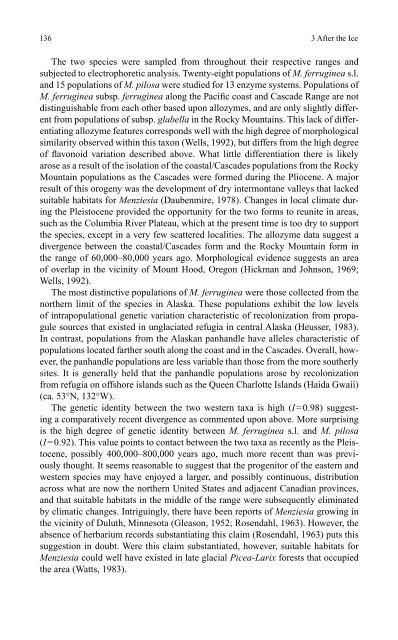The Geography of Phytochemical Races
The Geography of Phytochemical Races
The Geography of Phytochemical Races
You also want an ePaper? Increase the reach of your titles
YUMPU automatically turns print PDFs into web optimized ePapers that Google loves.
136 3 After the Ice<br />
<strong>The</strong> two species were sampled from throughout their respective ranges and<br />
subjected to electrophoretic analysis. Twenty-eight populations <strong>of</strong> M. ferruginea s.l.<br />
and 15 populations <strong>of</strong> M. pilosa were studied for 13 enzyme systems. Populations <strong>of</strong><br />
M. ferruginea subsp. ferruginea along the Pacifi c coast and Cascade Range are not<br />
distinguishable from each other based upon allozymes, and are only slightly different<br />
from populations <strong>of</strong> subsp. glabella in the Rocky Mountains. This lack <strong>of</strong> differentiating<br />
allozyme features corresponds well with the high degree <strong>of</strong> morphological<br />
similarity observed within this taxon (Wells, 1992), but differs from the high degree<br />
<strong>of</strong> fl avonoid variation described above. What little differentiation there is likely<br />
arose as a result <strong>of</strong> the isolation <strong>of</strong> the coastal/Cascades populations from the Rocky<br />
Mountain populations as the Cascades were formed during the Pliocene. A major<br />
result <strong>of</strong> this orogeny was the development <strong>of</strong> dry intermontane valleys that lacked<br />
suitable habitats for Menziesia (Daubenmire, 1978). Changes in local climate during<br />
the Pleistocene provided the opportunity for the two forms to reunite in areas,<br />
such as the Columbia River Plateau, which at the present time is too dry to support<br />
the species, except in a very few scattered localities. <strong>The</strong> allozyme data suggest a<br />
divergence between the coastal/Cascades form and the Rocky Mountain form in<br />
the range <strong>of</strong> 60,000–80,000 years ago. Morphological evidence suggests an area<br />
<strong>of</strong> overlap in the vicinity <strong>of</strong> Mount Hood, Oregon (Hickman and Johnson, 1969;<br />
Wells, 1992).<br />
<strong>The</strong> most distinctive populations <strong>of</strong> M. ferruginea were those collected from the<br />
northern limit <strong>of</strong> the species in Alaska. <strong>The</strong>se populations exhibit the low levels<br />
<strong>of</strong> intrapopulational genetic variation characteristic <strong>of</strong> recolonization from propagule<br />
sources that existed in unglaciated refugia in central Alaska (Heusser, 1983).<br />
In contrast, populations from the Alaskan panhandle have alleles characteristic <strong>of</strong><br />
populations located farther south along the coast and in the Cascades. Overall, however,<br />
the panhandle populations are less variable than those from the more southerly<br />
sites. It is generally held that the panhandle populations arose by recolonization<br />
from refugia on <strong>of</strong>fshore islands such as the Queen Charlotte Islands (Haida Gwaii)<br />
(ca. 53°N, 132°W).<br />
<strong>The</strong> genetic identity between the two western taxa is high (I = 0.98) suggesting<br />
a comparatively recent divergence as commented upon above. More surprising<br />
is the high degree <strong>of</strong> genetic identity between M. ferruginea s.l. and M. pilosa<br />
(I = 0.92). This value points to contact between the two taxa as recently as the Pleistocene,<br />
possibly 400,000–800,000 years ago, much more recent than was previously<br />
thought. It seems reasonable to suggest that the progenitor <strong>of</strong> the eastern and<br />
western species may have enjoyed a larger, and possibly continuous, distribution<br />
across what are now the northern United States and adjacent Canadian provinces,<br />
and that suitable habitats in the middle <strong>of</strong> the range were subsequently eliminated<br />
by climatic changes. Intriguingly, there have been reports <strong>of</strong> Menziesia growing in<br />
the vicinity <strong>of</strong> Duluth, Minnesota (Gleason, 1952; Rosendahl, 1963). However, the<br />
absence <strong>of</strong> herbarium records substantiating this claim (Rosendahl, 1963) puts this<br />
suggestion in doubt. Were this claim substantiated, however, suitable habitats for<br />
Menziesia could well have existed in late glacial Picea-Larix forests that occupied<br />
the area (Watts, 1983).
















